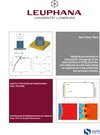Modeling the evolution of intermetallic compounds at the weld interface of Al-Mg dissimilar joint obtained via solid-state joining for applications in the automotive and aerospace industry
von Syed Hasan RazaIndustries are seeking sustainable solutions, which has prompted
the adoption of lightweight materials, such as aluminum and
magnesium, in the aerospace and automotive industries. Joining
dissimilar materials, such as aluminum and magnesium, offers the
potential for multi-material structures with the synergy of the desirable
properties. However, the excessive formation of intermetallic
compounds at the joint interface can negatively affect its mechanical
properties. Solid-state joining techniques offer a solution,
as they operate at lower temperatures, which limits intermetallic
compound thickness.
Combining numerical techniques, such as the finite-element and
multiphase-field methods, can facilitate intermetallic compound
evolution investigation during solid-state joining processes. This
study employs the former to simulate the refill friction stir spot
welding process for joining aluminum and magnesium and the latter
to investigate the evolution of intermetallic compounds at the
joint interface. The process simulation provides a temperature and
strain profile at the joint interface, which drives the evolution of intermetallic
compounds. The multiphase-field model is used to analyze
the morphology and kinetics of the intermetallic compound
under driving forces, such as chemical and mechanical effects.
Various parameters, such as interface energy, grain boundary diffusion,
and initial microstructure, are examined and demonstrated
to impact the final morphology and kinetics of the intermetallic
compounds. Combining such numerical techniques offers a framework
for studying intermetallic compound evolution in various solid-
state joining processes and material systems.
the adoption of lightweight materials, such as aluminum and
magnesium, in the aerospace and automotive industries. Joining
dissimilar materials, such as aluminum and magnesium, offers the
potential for multi-material structures with the synergy of the desirable
properties. However, the excessive formation of intermetallic
compounds at the joint interface can negatively affect its mechanical
properties. Solid-state joining techniques offer a solution,
as they operate at lower temperatures, which limits intermetallic
compound thickness.
Combining numerical techniques, such as the finite-element and
multiphase-field methods, can facilitate intermetallic compound
evolution investigation during solid-state joining processes. This
study employs the former to simulate the refill friction stir spot
welding process for joining aluminum and magnesium and the latter
to investigate the evolution of intermetallic compounds at the
joint interface. The process simulation provides a temperature and
strain profile at the joint interface, which drives the evolution of intermetallic
compounds. The multiphase-field model is used to analyze
the morphology and kinetics of the intermetallic compound
under driving forces, such as chemical and mechanical effects.
Various parameters, such as interface energy, grain boundary diffusion,
and initial microstructure, are examined and demonstrated
to impact the final morphology and kinetics of the intermetallic
compounds. Combining such numerical techniques offers a framework
for studying intermetallic compound evolution in various solid-
state joining processes and material systems.






